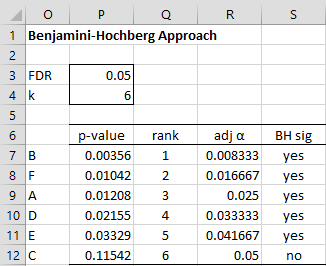Benjamini-Hochberg’s Test
For Benjamini-Hochberg’s adjustment, we again start with the largest p-value pk (where p1 ≤ p2≤ … ≤ pk are the p-values of the multiple tests in ascending order) and identify the first i (staring from k) such that pi < (i/k)α. Once this is found then tests 1, …, i are considered to be significant and the other tests are not significant.
Example 1: Repeat Example 1 of Dealing with Familywise Error using the Benjamini-Hochberg method.
The result is shown in Figure 1. E.g. cell R8 contains the formula =P$3*Q8/P$4. The formulas in column S are identical to those used in column M of Figure 1 of Holm’s and Hochberg’s Tests.
Figure 1 – Benjamini-Hochberg test
Since the largest p-value for which pi < (i/k)α is i = 5 (i.e. p5 =.03329 < .041667), we conclude that all but test 6 (i.e. C) are significant.
This approach is more powerful than those considered previously; i.e. it accepts more risk of type I error in exchange for a lower type II error. This is appropriate when we have a large number of tests, especially when this is a filtering step for follow-up tests. In this case, we can accept a larger number of false positives since these will be removed in subsequent testing. This is often the case, for example, in genetic research.
Actually, in this approach, the alpha is considered to be a false discovery rate (FDR), reflecting the fact that we are willing to accept multiple type I errors (instead of trying to avoid even one type I error, as in the significance level). An FDR set at 5% means that we expect that 5% of the rejections of the null hypothesis will be wrong.
Finally note that in the Dunn-Sidàk version of the Benjamini-Hochberg test, we use the formula =1-(1-P$3)^(Q8/P$4) in cell R8.
Benjamini-Yekutieli’s Test
The Benjamini-Yekutieli approach is similar to the Benjamini-Hochberg approach, but instead of finding the test j = max {i: pi < (i/k)α}, we seek j = max {i: pi < (i/k)α′} where α′ = α/. This test is more conservative than the Benjamini-Hochberg test.
Example 2: Repeat Example 1 of Dealing with Familywise Error using the Benjamini-Yekutieli method.
The approach shown in Figure 2 is identical to that for the Benjamini-Hochberg method shown in Figure 1, except that α =.05 is replaced by α′ = .02408 (cell V3) which can be calculated in Excel by the formula =0.05/SUMPRODUCT(1/W7:W12). This time, none of the environmental factors are found to be significant.
Figure 2 – Benjamini-Yekutieli test
Examples Workbook
Click here to download the Excel workbook with the examples described on this webpage.
References
Wikipedia (2018) False discovery rate
https://en.wikipedia.org/wiki/False_discovery_rate
Benjamini, Y. and Yekutieli, D. (2001) The control of the false discovery rate in multiple testing under dependency. Ann. Statist. 29(4): 1165-1188.
https://projecteuclid.org/journals/annals-of-statistics/volume-29/issue-4/The-control-of-the-false-discovery-rate-in-multiple-testing/10.1214/aos/1013699998.full
Benjamini, Y. and Hochberg, Y. (1995) Controlling the false discovery rate: a practical and powerful approach to multiple testing. J. Roy. Statist. Soc. Ser. B 57 289–300
https://www.stat.purdue.edu/~doerge/BIOINFORM.D/FALL06/Benjamini%20and%20Y%20FDR.pdf


Dear Charles,
You mention “For Benjamini-Hochberg’s adjustment, we again start with the largest p-value”, but when I look at the original article (Benjamini & Hochberg, 1995) they mention: ‘let P_(1) <= P_(2) <= … <= P_(m)….Let k be the largest i for which P_(i) <= i/m times q*….the procedure controls the FDR at q*'.
This seems to suggest to start with the lowest not the largest. Am I missing something?
Hello Peter,
The sequence of probabilities starts with the lowest, but the test looks for k = the largest i such that P(i) <= (i/m)q*. To find the largest i, you should start at the largest p-value. You can start at the lowest p-value, but even if you find an i that satisfies the inequality, you will still need to proceed in case you find a higher i that satisfies the inequality. Charles
Many thanks, usefully
valli
Thank you so so much! My sister and I really appreciate your website and all its resources. I can imagine the time and effort it must take to maintain such a great blog. Please keep it going. We have shared your website and videos to all our friends.
Warm regards
Lara and Mike
Thank you, Lara and Mike.
I appreciate your support. I plan to keep the website and software going.
Charles
Hi,
great that multiple correction is included in the pack. Unfortunately I always obtain error “Last column of input must consist only of numeric values between 0 and 1; first invalid entry is at cell “. Even if all the cells have numeric value between 0 and 1. What am I doing wrong?
Thanks
Hi Riku,
If you email me an Excel workbook with your data, I will try to figure out what has gone wrong.
Charles